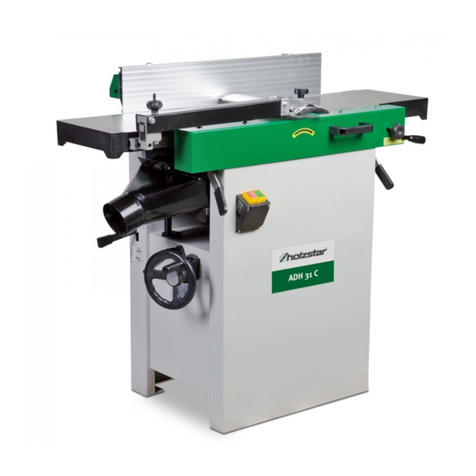
Safety
DH-Series | Version 1.01 7
2.7 General safety instruction
- The design of the machinery must not be altered
and it must not be used for purposes other than
those provided for by the manufacturer.
- Use the safety devices. Never work without guards
and keep them operational. Check the functiona-
lity before starting work.
- Always keep the machine and your working env-
ironment clean and free of obstacles!
- Never work under the influence of concentration-
disturbing illnesses, fatigue, drugs, alcohol or me-
dication.
- Remove tool keys, set-up tools and other loose
parts from the machine after assembly or repair
before switching on the machine.
- All safety and danger instructions on the machine
must be observed and kept in perfect condition.
- Keep children and persons not familiar with the
machine away from your working environment, the
machine and tools.
- The machine may only be used, equipped and
maintained by persons who are familiar with it and
have been informed of the dangers (minimum age
18 years).
- If the machine is moved, even at a short distance,
it must be disconnected from the mains supply.
Before the machine is put back into operation, it
must be properly connected to the power supply.
- The operator must switch off the engine when lea-
ving the workplace. Pull out the plug! Disconnect
the appliance when not in use.
- The machine can only be used if it is connected to
the effective chip and dust extraction system.
- The machine must be earthed. The yellow / green
wire is the grounding cable.
- Only tools according to EN 847-1: 2005 may be
used. Check the machine at each start to ensure
that the protective equipment and switches are in
order. Do not use the machine if the protective
equipment, the switch, the electrical connections,
the plug or other parts of the machine are dama-
ged.
- Do not pull on the power cord to pull the plug out
of the socket.
- When using this equipment, avoid physical con-
tact with grounded objects (e.g. pipes, radiators,
electric cookers, refrigerators).
- Wear tight-fitting work clothing, safety glasses,
safety shoes, and hearing protection. Tie long hair
together. Do not wear jewellery such as watches,
bracelets, necklaces, rings, scarves or gloves
(moving/rotating parts!) when working.
- Never leave the machine unattended in operation
and remain with the machine until the tool has
come to a complete standstill. Then pull the mains
plug to protect against unintentional switch-on.
- Do not remove the workpiece until the tool has
come to a complete stop and you have switched
off the machine.
- Protect the machine from moisture (danger of
short circuit!).
- Never use electric tools and machines in the vici-
nity of flammable liquids and gases (danger of ex-
plosion!).
- Faults which impair safety must be rectified imme-
diately.
- Before each use of the machine, make sure that
no parts are damaged. Damaged parts must be
replaced immediately to avoid sources of danger!
- Do not overload the machine! You will work better
and safer in the specified performance range. Use
the correct tool! Ensure that the tools are not da-
maged.
- Do not use faulty or damaged extension cords.
- Only use original spare parts and accessories to
avoid possible hazards and accident risks.
- Only use the accessories recommended for this
unit.
- Follow the instructions provided with the accesso-
ries. The use of incorrect accessories can lead to
hazards.
- Use only accessories designed for this machine to
avoid injury from ejected parts or workpieces.
- Do not use accessories unless you have fully read
the manual or operating instructions for this acces-
sory.
- To avoid injury from unexpected start-up, do not
plug the power cord into a wall outlet during un-
packing and installation. This cable must always
be disconnected when assembling or adjusting
the unit.
- If any part is missing or damaged, do not connect
the equipment until the missing or damaged part
has been replaced and assembly is complete.
- Do not use blunt cutting blades as this will in-
crease the risk of setbacks.
- If short pieces of wood are to be planed, position
the workpieces with a sliding stick.
- Do not use the machine for folding or rolling wood.
- Regularly check that the cutting block and the
non-return device are working properly.
- Only use well sharpened cutting blades to work
better and safer.
- Do not use cracked cutting blades or blades that
are no longer in their original shape.
- Use appropriate aids to support heavy or bulky
parts when they are to be used. Such aids are the
additional units: Jack-up and Universal Trucks.
ATTENTION!
Repairs, maintenance and upgrades may only be
carried out by qualified personnel with the machine
switched off and secured (pull the mains plug!)!




























